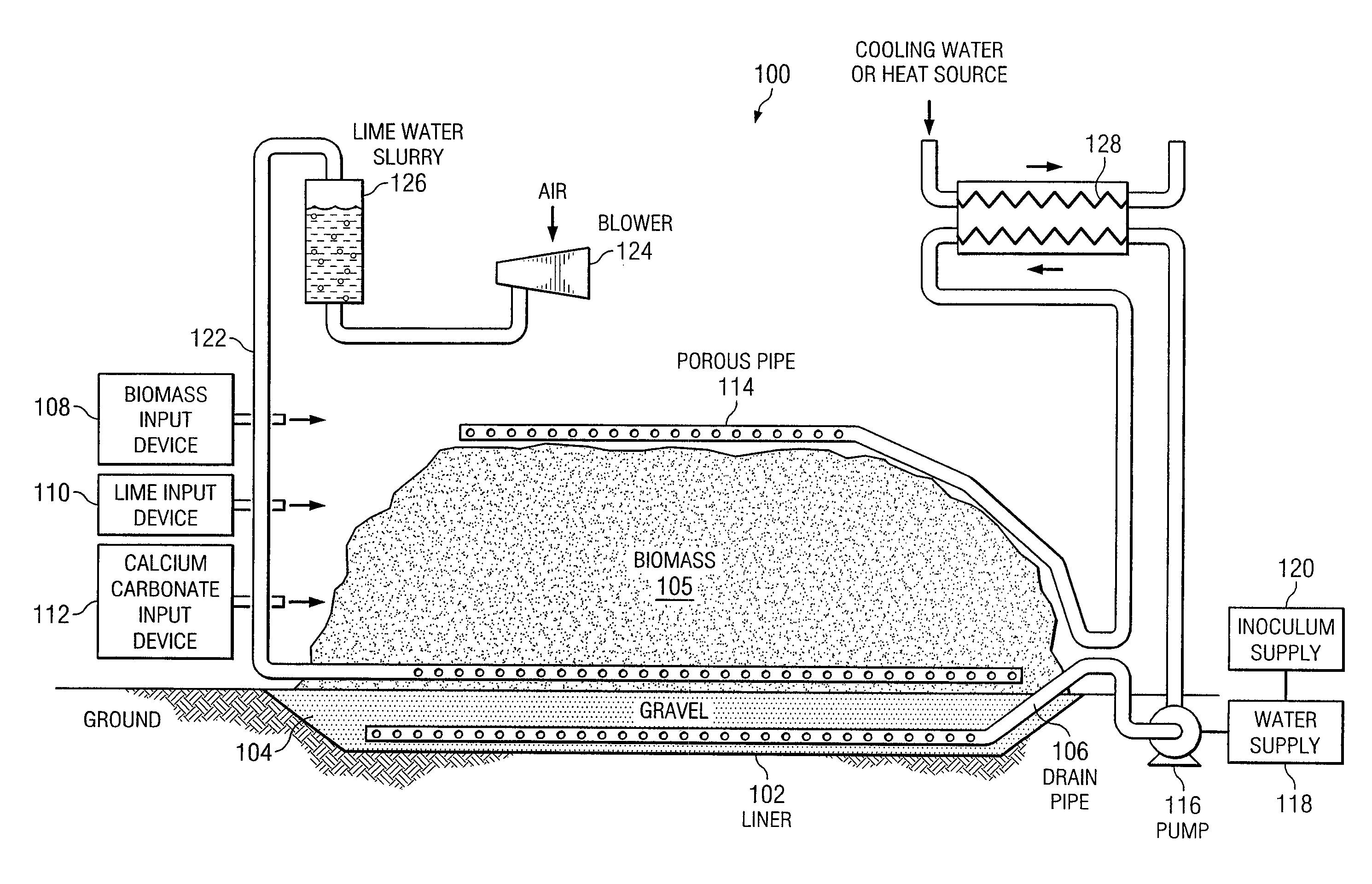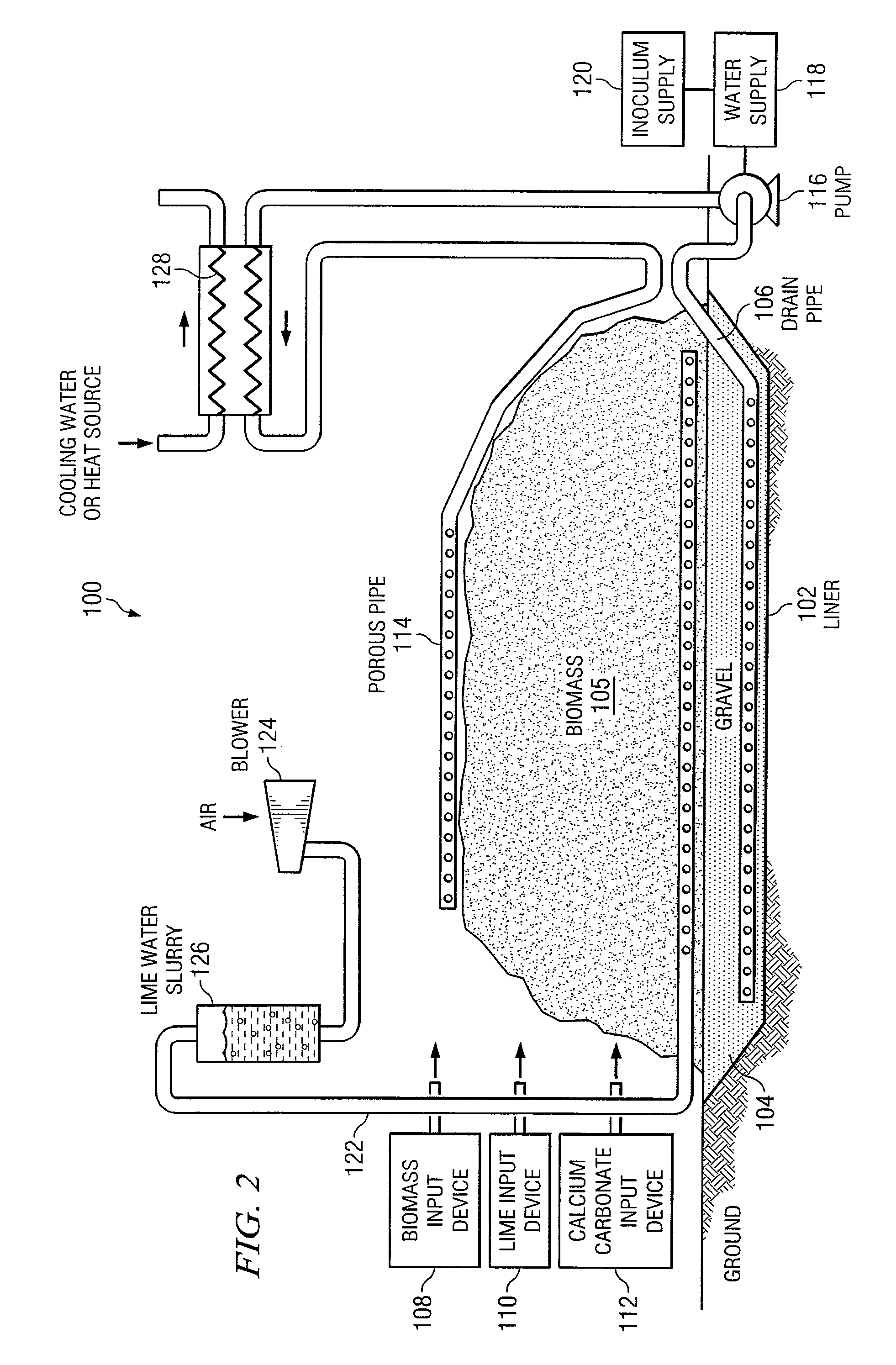Methods and Systems for Pretreatment and Processing of Biomass
a biomass and pretreatment technology, applied in the field of biomass pretreatment and processing, can solve the problems of expensive treatment vessels and methods that use expensive chemicals, and achieve the effect of increasing the enzyme digestibility of biomass and reducing the content of lignin in biomass
- Summary
- Abstract
- Description
- Claims
- Application Information
AI Technical Summary
Benefits of technology
Problems solved by technology
Method used
Image
Examples
example 1
General Pretreatment Conditions
[0177]Specific embodiments of the present invention include lignocellulosic biomass treatment with lime only or lime with circulated air, including oxygen enriched air. Such embodiments may be used to treat, for instance corn stover and bagasse. The general conditions of these embodiments are as follows:
[0178]Pressure: 1 atm or ambient pressure to avoid the need for pressure vessels.
[0179]Temperature: Temperatures ranging from 25 to 57° C. As expected, lignin removal is more rapid at higher temperatures. In principle, the reaction could be operated as high as 100° C. and the pressure would remain 1 atm. However, at 100° C., the partial pressure of water would be 1 atm and the partial pressure of air would be 0 atm. In this case, the benefits of oxidizing the lignin could not be realized. Therefore, it is advisable to reduce the temperature to reduce the water partial pressure. The following table provides guidance in temperature selection:
Temperature (...
example 2
Preliminary Experiments to Determine Process Conditions and their Effects
[0187]Biomass delignification by lime treatment occurs very quickly at high-temperature and high-pressure oxygen conditions (Chang, S. “Lime Pretreatment of Lignocellulosic Biomass”, Ph. D. Dissertation, Texas A&M University, May 1999). To determine whether long-term delignification treatment was feasible, an experiment was conducted in which sugarcane bagasse underwent lime pretreatment using air purging at temperatures lower than 60° C.
[0188]The dry weight of raw sugarcane bagasse (35 mesh) was determined using the NREL Standard Procedure No. 1 (NREL (1992). Chemical Analysis & Testing Standard Procedure, National Renewable Energy Laboratory, Golden, Colo.). Several 125-mL Erlenmeyer flasks were loaded with 3 g dry weight of sugarcane bagasse, 1.5 g of Ca(OH)2 (50% loading) (Fisher Scientific Co.) and 27 mL of distilled water. Several flasks used air as the oxygen source. An equal number of flasks had no air ...
example 3
General Conditions and Methods
[0236]The following conditions and methods were used in the experiments of Example 4 and may be readily adapted by one of skill in the art to determine other suitable embodiments of the present invention.
Particle Size Distribution of Raw Biomass
Sieves
[0237]USA standard testing sieves (A.S.T.M.E.-11 Specification)
TABLE ASpecification of SievesSieve numberTyler EquivalentOpening sizeMeshmmin444.7500.187020200.8500.033130280.6000.023440350.4250.016550480.3000.011780800.1800.00701001000.1500.0059
Procedures
[0238]50 g dry biomass was loaded on the sieve of mesh No. 100. The lid, bowl and seive apparatus was vigorously shaken in a horizontal plane for 1 minute. The particles collected in the seive were stored. Particles in the bowl where transferred to a seive of lower mesh number and the process was repeated until mesh No. 4 was reached. All samples from seives were dried at 105° C. for 24 hours, then weighed to determine dry weight for particles collected by...
PUM
| Property | Measurement | Unit |
|---|---|---|
| thick | aaaaa | aaaaa |
| temperature | aaaaa | aaaaa |
| temperature | aaaaa | aaaaa |
Abstract
Description
Claims
Application Information
 Login to View More
Login to View More - R&D
- Intellectual Property
- Life Sciences
- Materials
- Tech Scout
- Unparalleled Data Quality
- Higher Quality Content
- 60% Fewer Hallucinations
Browse by: Latest US Patents, China's latest patents, Technical Efficacy Thesaurus, Application Domain, Technology Topic, Popular Technical Reports.
© 2025 PatSnap. All rights reserved.Legal|Privacy policy|Modern Slavery Act Transparency Statement|Sitemap|About US| Contact US: help@patsnap.com



